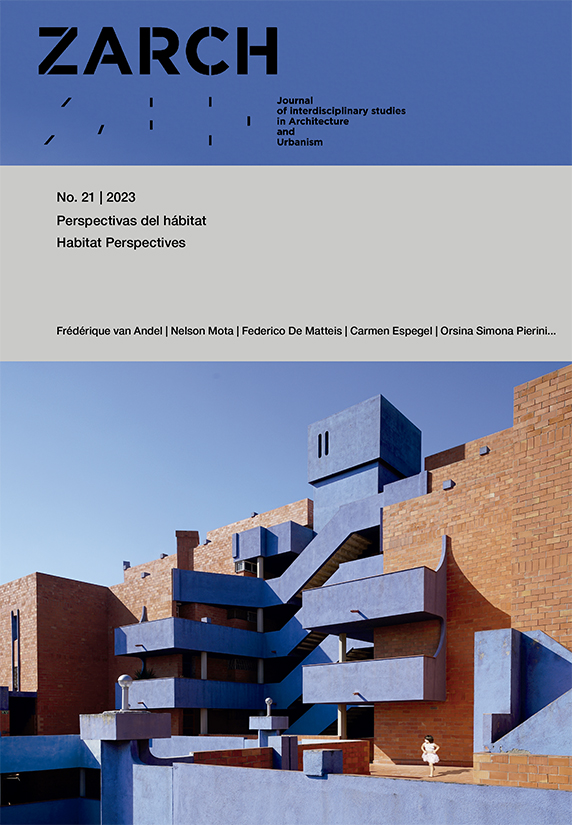Informal Habitat. The Balance Induced by Écochard Between Rehousing Models and Spatial Organization Aproches in Casablanca
DOI:
https://doi.org/10.26754/ojs_zarch/zarch.2023218921Keywords:
Bidonvilles, Rehoming, Habitat, World War II, House Yard, CasablancaAbstract
The need for refuge must be satisfied through an architectural form and the order in the landscape that occurs there, through all the instinctive tools that promote survival. This was the case with the shantytowns that were grouped in the industrial zone of the city of Casablanca, during the post-war period. A transition period from 1945 to 1956, between the end of colonialism and the beginning of decolonization, where informal agglomerations called 'bidonvilles' proliferated. In their attempt to structure the city in the face of these spontaneous masses, new studies made their way, anticipating ideas and projects on behaviors and ways of inhabiting the place itself. An entire experimental laboratory that collected past and future forms of life, with the aim of defining a housing model capable of establishing the most opportune balance for relocation to this anticipated city, which only time in its knowledge will reveal.
Downloads
References
Avermaete, Tom. Another Modern: the post-ward architecture and urbanism of Candilis-Josic-Woods. Rotterdam: Nai Publishers, 2005.
Aquilué Junyent, Inés; Roca Blanch, Estanislau. “Bijlmermeer, cambio e hibridación en la ciudad del futuro”. ZARCH 12 (junio 2019): 210-223. https://doi.org/10.26754/ojs_zarch/zarch.2019123388
Çelik, Zeynep. Urban Forms and Colonial Confrontations. Algiers Under French Rule. Berkeley: University of Califormia Press, 1997.
Cohen, Jean Louis. Casablanca, de la cité de l’énergie à la ville fonctionnelle. En: Architectures Française d’Outre-Mer, Dir. Culot M. y Thiveaud J. M., Instituto francés de arquitectura, obra misión histórica de la Caja de Depósitos y Consignaciones, Coll. Villes. Liège: Ed. Mardaga, 1992.
Cohen, Jean Louis; Eleb, Monique. Casablanca: Mythes et figures d´une aventure urbaine, Paris: Hazan, 1998.
Dethier, J. 60 ans d´urbanisme au Maroc. Rabat: Bulletin Economique et Social du Maroc, 1972.
Díaz-Y. Recasens, Gonzalo. Recurrencia y herencia del patio en el movimiento moderno. Sevilla: Universidad de Sevilla: Consejería de Obras Públicas y Transportes, 1992.
Durand, Jean Nicolas Louis. Preçis des Leçons d´Architecture données a l´École Royale Polytechnique. Vol. 2. Paris: L´École Royale Polythechnique, 1923-25.
Écochard, Michel. Casablanca. Le roman d’une ville. París: Editions de Paris, 1955 (1954).
_____. La nouvelle organisation du Service de l’Urbanisme au Maroc. Paris: Bulletin de la Grande Masse, 1er trimestre 1949.
Hervio, Pierre. “Habitat Marocain Urbain. Constructions Diverses”. Traveaux244 (febrero 1955): 33.
Le Corbusier. Principios de Urbanismo (La Carta de Atenas). Barcelona: Planeta Agostini, 1993.
Marlène, Ghorayeb. L´urbanisme de la ville de Beyrouth sous le mandat français. Revue du monde musulmán et de la Méditerranée. Paris: Parcourir, 1994.
Parfait, François. “Conception, organisation, réalisation des ensembles d´habitation”. Urbanisme 28e année, núm.65, 1959.
Pezzoli, K. Human Settlements and Planning for Ecological Sustainability. The Case of Mexico City. Cambridge: MIT Press, 1998.
Risselada, Max; Van den Heuvel, Dirk (eds.). Team 10: 1953-81: in search of a utopia of the present. Rotterdam: Nai Publishers, 2005.
Smithson, Alison; Smithson, Peter. Cambiando el arte de habitar. Barcelona: Gustavo Gili, 2001.


